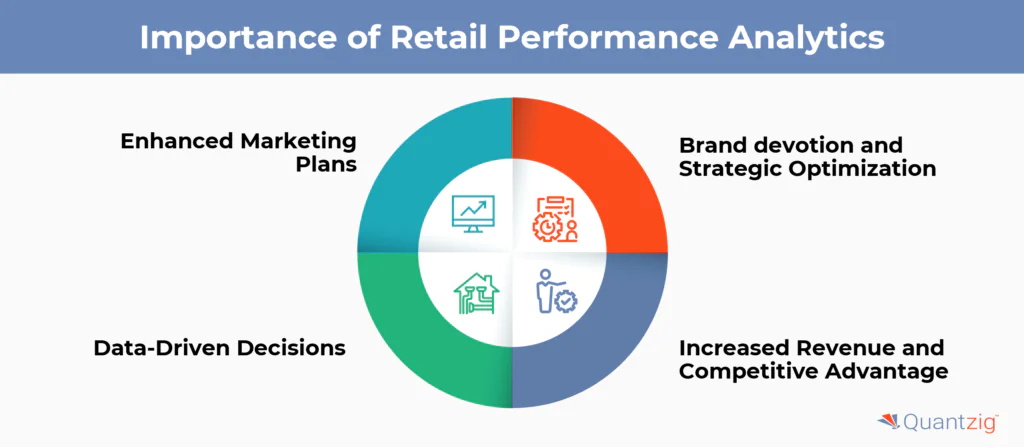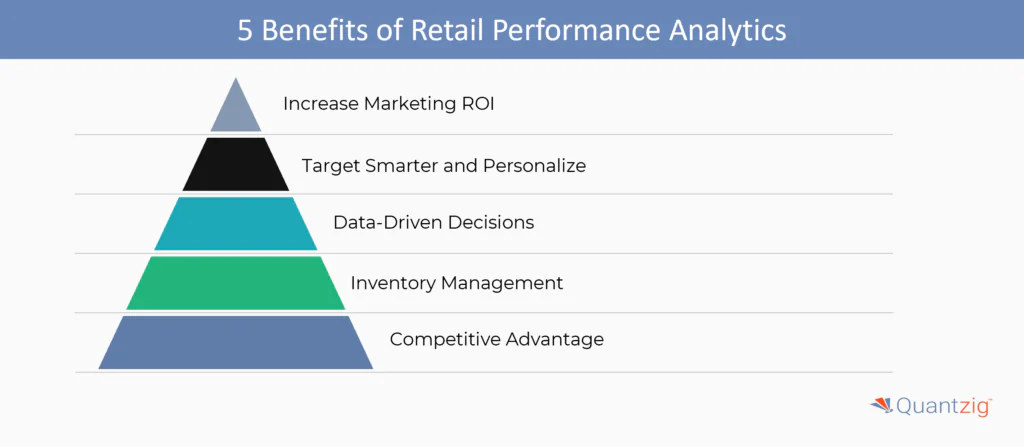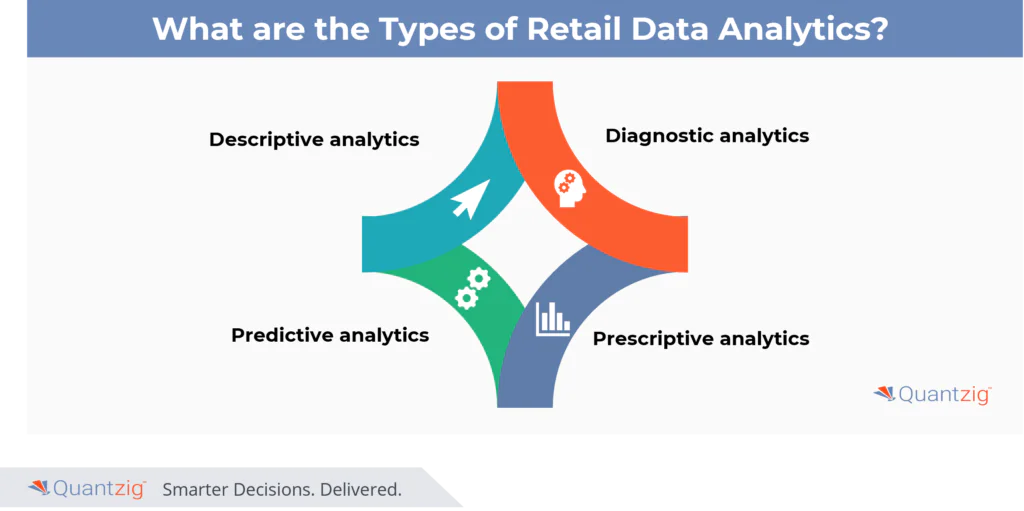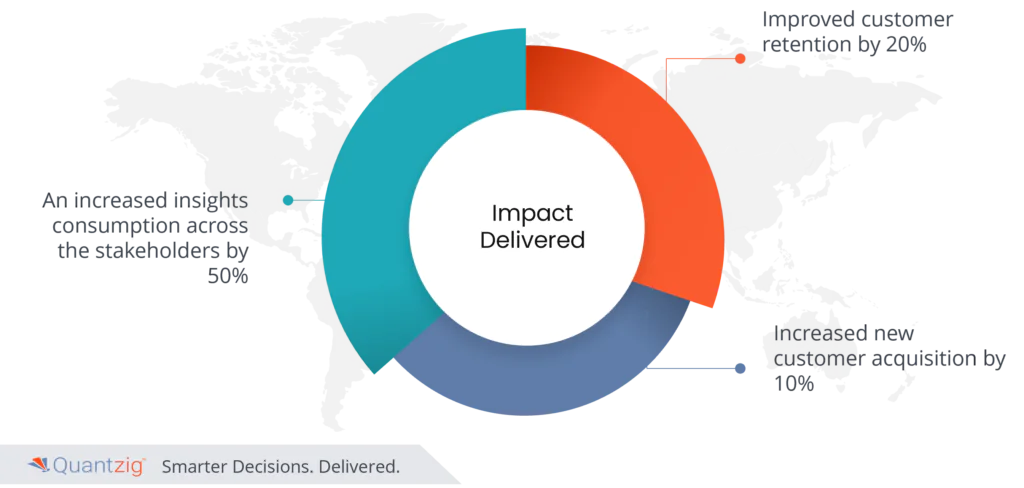Written By: Sudeshna Ghosh
Table of Contents
Key Takeaways for Retail Performance Analytics
- Retail performance analytics empowers marketers with invaluable data-driven insights gleaned from sales, customer buying behavior, and campaign performance analysis, enabling them to enhance strategies, target audiences effectively, personalize experiences, and drive both sales and brand loyalty.
- Quantzig’s retail performance analytics tools helped a UK-based retail company to achieve an increased insights consumption across the stakeholders by 50%, improved customer retention by 20%, and increased new customer acquisition by 10%.
- Types of retail data analytics include descriptive, diagnostic, predictive, and prescriptive analytics, which respectively provide insights into past performance, root causes of issues, future outcomes, and AI-driven recommendations for optimal actions.
- Quantzig’s retail performance analytics solution leverages advanced data analytics techniques to provide retailers with actionable insights, driving optimization in sales, customer experiences, and overall business performance.
Introduction
Retailers in the past depended mostly on their instincts and hunches, which they developed over many years of experience, to make decisions about what products to sell, which places would probably attract the most customers, how much inventory to have on hand, and when to change prices. But nowadays, shoppers are too fickle and market situations are too complex for people to accurately consider all those factors. Data analytics tools can assist retailers in making more accurate and profitable decisions by enhancing—and sometimes revising—those well-informed hunches.
By analyzing data from various sources including POS systems, analytics and reporting systems, online sales, and social media platforms, Quantzig helps retailers identify patterns, trends, and chances to enhance their operations and increase customer happiness. From this case study, you’ll understand how our retail performance analytics tools helped a UK-based retail company to achieve an increased insights consumption across the stakeholders by 50%, improved customer retention by 20%, and increased new customer acquisition by 10%.
Book a demo to experience the meaningful insights we derive from data through our analytical tools and platform capabilities. Schedule a demo today!
Request a Free DemoHow does Retail Performance Analytics hold importance for businesses?

Retail data analytics provides marketers with invaluable insights. Examining sales figures, customer actions, and campaign results uncovers key information to enhance marketing plans and boost success. These understandings empower marketers to make data-informed decisions, focus on suitable modern consumers, tailor the customer journey, and ultimately increase revenue and brand devotion. Analytics offers marketers the critical knowledge to optimize tactics and accomplish improved outcomes. Assessing retail performance data is a treasure trove that enables marketers to gain essential perspective to elevate strategy and performance.
Retail Performance Analytics is an important tool in modern business operations, leveraging advanced cutting-edge technologies such as AI and Machine Learning to analyze Key Performance Indicators (KPIs) or retail KPIs, and drive strategic decision-making. By harnessing data from various sources such as customer lifecycle analysis, business intelligence dashboard, web analytics, In-store analytics, merchandise analytics, merchandise attribute analytics, analytics and reporting systems, and inventory management systems, businesses gain invaluable insights into their operations.
Through visualizations and statistical models, Retail Performance Analytics enables organizations to identify trends, understand market dynamics, and optimize inventory and merchandise management. This, coupled with personalized marketing strategies and enhanced customer satisfaction, provides a competitive advantage in today’s multichannel retail landscape. With Retail Performance Analytics, businesses can make data-driven decisions, monitor store performance, make long-lasting customer relationships, align their strategic planning with market demands, and ultimately drive growth and success in the retail sector.
5 Benefits of Retail Performance Analytics to gain Market Leverage
The retail industry requires retail performance analytics for marketers to improve their strategies and foster growth. By leveraging data insights, marketers can tackle various obstacles and unlock opportunities to enhance their marketing initiatives. We examine some key benefits of conducting retail performance analytics for marketing and how they address common challenges for retail marketers.
1. Increase Marketing ROI:
A major challenge for marketers is maximizing return on investment (ROI) from marketing activities. Retail performance analytics allow marketers to monitor campaign performance in real-time, optimize budgets, and allocate resources to high-performing campaigns. By prioritizing initiatives with the greatest ROI, marketers can ensure their efforts align with business goals and drive tangible outcomes.
2. Target Smarter and Personalize:
With increasing personalization, understanding customer behavior is vital for marketers. However, without strong analytics capabilities, targeting and personalization work may be inadequate. Retail performance analytics allows marketers to gain deep insight into customer preferences, behaviors, and buying patterns. With this information, marketers can create targeted campaigns tailored to specific customer groups, leading to stronger relationships, more engagement, and higher sales.
3. Data-Driven Decisions:
Making decisions based on real customer data is important for marketers looking to stay ahead of the competition. Retail performance analytics enables marketers to move beyond guesses and rely on data-driven insights to inform key decisions. Whether setting pricing strategies, designing promotions, or launching new products, having access to comprehensive data insights ensures marketers can make decisions that connect with their target modern consumers and drive business success.
4. Inventory Management:
For retail IT decision-makers, effectively managing inventory is vital to ensure smooth operations, increase customer loyalty, and fulfill customer demand. However, without accurate insights into sales data, efforts to optimize on-hand inventory can be challenging. Retail analytics provides marketers with valuable understanding into sales patterns, demand cycles, and inventory quantities. By examining this data, marketers can predict demand, avoid stockouts, and prevent overstocking, guaranteeing ideal inventory administration and a seamless shopping experience for customers.
5. Competitive Advantage:
In today’s highly competitive retail landscape, gaining a competitive edge is critical for marketers. Retail analytics offers marketers an invaluable opportunity to gain insights into customer behavior, market trends, and competitor tactics. By leveraging these insights, retail IT decision-makers can enhance their campaigns, refine their strategies, and stay ahead of the competition. Whether it’s spotting emerging trends, discovering new opportunities, or adapting to shifting modern consumers’ preferences, retail analytics enables marketers to maintain a competitive advantage in the dynamic retail business.
In summary, taking advantage of retail performance analytics provides marketers with various benefits that can tackle prevalent issues faced in retail. From increasing marketing return on investment to enabling smarter segmentation and personalization, retail performance analytics allows marketers to make data-informed choices, improve inventory administration, enhance retail businesses’ performance, and gain a competitive advantage in the market. By leveraging the power of data insights, marketers can conquer obstacles, make proper strategic planning, spur growth, create long-lasting customer relationships, and attain success in the current fast-moving retail environment.
Also Read: How can Retail Marketing Analytics help with rise in Sales Margin?
What are the Types of Retail Data Analytics?
Retail data analytics can be categorized into four main types: descriptive, diagnostic, predictive, and prescriptive.
- Descriptive analytics focuses on reporting historical data to answer questions about what happened – how many sales, when and where purchases occurred, inventory levels over time, etc. This provides a foundation for more advanced analytics.
- Diagnostic analytics goes deeper to identify the root causes behind retail performance issues. By combining different data sources like customer feedback, financials, and operations, retailers can pinpoint problems.
- Predictive analytics forecasts potential future outcomes through modeling and what-if scenarios. Variables like weather, economic factors, supply chain, and competition are analyzed to estimate results of different decisions like discount percentages.
- Prescriptive analytics uses AI and big data to recommend actions based on predictive outcomes. For example, it can suggest customized offers for service agents to provide customers based on past purchases and current inquiries.
Quantzig’s Success Story
| Client Details | A leading UK-based retail company with annual revenue of $1Bn+. |
| Challenges Faced by The Client | Our client was facing several challenges with their present marketing strategy, resulting in ineffective marketing campaigns and decreasing returns on investment. |
| Solutions Offered by Quantzig | Quantzig’s Marketing Return on Investment Engine for Retail utilized advanced data processing methods, such as AI-powered data extraction and automated quality assurance, to create actionable insights for targeted marketing campaigns, personalized communications, and complaint handling. By incorporating data enrichment and an intelligence layer, our solution streamlined marketing initiatives, improves customer interaction, and produces quantifiable outcomes for the retail customers. |
| Impact Delivered | An increased insights consumption across the stakeholders by 50%, improved customer retention by 20%, and increased new customer acquisition by 10%. |
Client Details
A leading UK-based retail company with annual revenue of $1Bn+.
Challenges Faced by the Client
Our client was facing several challenges with their present marketing strategy, resulting in ineffective marketing campaigns and decreasing returns on investment.
The data was sourced from multiple sources and was combined and further processed to generate marketing insights and dashboards. The main challenges were: 1. Poor data structuring and formatting. 2. Low data quality. 3. Inconsistencies in external data. 4. Additional quality control effort was required to ensure proper data harmonization. 5. Delayed and low-quality insights, leading to lower insights consumption.
Solutions Offered by Quantzig:
- We developed a Marketing Return on Investment Engine for our Retail Client with the goal of generating actionable insights focused on targeted campaigns, personalized messaging, and improved resolution of complaints to achieve better results from marketing efforts.
- We examined all new data sources, removed those not adding value, and processed the remaining data through our data enrichment system which organized the information by format, completeness, etc. We leveraged AI for data extraction and merged it with API-sourced data.
- After extraction, we utilized our Automated Data Management Framework designed for mostly automated quality control resulting in high quality, low effort data and rules to automatically fix common data issues. The enriched and processed data was then passed through our Intelligence layer to provide insights across marketing campaigns.
Get started with your complimentary trial today and delve into our platform without any obligations. Explore our wide range of customized, consumption driven analytical solutions services built across the analytical maturity levels.
Start your Free Trial TodayImpact Delivered:
The solution contributed to boosting the use of insights by stakeholders by 50%. It also enabled more data-driven choices based on those insights. This helped improve customer retention by 20% and acquire 10% more new customers. Feedback gathered from social interactions assisted long-term product innovation and faster resolution of any grievances.
Retail Performance Analytics: A deep dive
Retail analytics makes use of software to gather and study information from physical stores, online shops, and catalogue sales. This allows retailers to gain understanding of customer actions and shopping inclinations. Retail Performance Dashboards can also enhance decisions regarding pricing, inventory, marketing, merchandising, and store functions. This is done by applying predictive algorithms to data from internal sources (like customer buy histories) and external sources (like weather projections). Furthermore, this tool can evaluate customer devotion, identify buying patterns, foresee demand, and enhance store layouts. For example, retailers can position items on shelves that customers often purchase together. Or provide customized discounts to frequent shoppers that will lead to larger average basket sizes and more frequent visits.
Retail Performance Analytics has emerged as a game-changer, harnessing the power of AI and Machine Learning to unlock valuable insights. Through sophisticated visualizations, Business Intelligence Dashboard, and comprehensive business intelligence (BI) reports, organizations can delve deep into their operations, leveraging key performance indicators (KPIs) to drive informed decision-making. By integrating data from diverse sources such as inventory management systems, analytics and reporting systems, multichannel analytics, merchandise attribute analytics, web analytics, customer lifecycle analysis, and inventory analytics, retailers gain a holistic view of their business landscape. This enables them to optimize merchandise analytics, analyze technology investments, enhance retail business performance, and craft targeted personalized marketing strategies for personalized customer engagement and increased customer loyalty.
Ultimately, Retail Performance Analytics empowers retail IT decision-makers to gain a competitive advantage by navigating market dynamics with agility, implementing effective multichannel analytics, and aligning with strategic business intelligence initiatives. Through the utilization of statistical models, retail performance dashboards, and in-store analytics, retailers can fine-tune their operations, mitigate inventory risk and compliance issues, and make proper strategic planning related to technology investments, ensuring that every aspect of their merchandise attribute analytics contributes to overall success.
Upgrade Your Retail Performance Analytics with Quantzig
Unlock the immense potential of your retail business by using Quantzig’s innovative Retail Performance Analytics platform. Harnessing state-of-the-art technology and robust data science capabilities, we provide in-depth insights into your retail operations, empowering you to refine marketing tactics, elevate customer satisfaction, and stimulate enduring expansion. Our bespoke methodology integrates advanced data processing techniques, AI-powered analytics, and actionable suggestions to maximize your marketing ROI, enhance inventory organization, and attain a competitive lead in the market. With our expertise, you can make well-informed decisions, streamline workflows, and stay ahead of the curve in the dynamic retail industry today. Elevate your retail performance analytics with Quantzig and commence a journey to success and profitability.
Improve your retail operations with Quantzig’s cutting-edge AI and Machine Learning-powered Retail Performance Analytics solution. Through advanced visualizations, Business Intelligence tools, Retail Performance Dashboards, and comprehensive Business Intelligence (BI) Reports, our platform provides actionable insights into crucial Key Performance Indicators (KPIs), enabling data-driven decision-making. By integrating data from various sources including Inventory Management Systems, Multichannel analytics, In-store analytics, Inventory Analytics, business intelligence dashboard, customer lifecycle analysis, and Web Analytics, our solution offers unparalleled visibility into inventory analytics, technology investments, and merchandise analytics.
This empowers retailers to enhance retail business performance and devise targeted personalized marketing strategies for personalized customer experiences and enhanced customer satisfaction and customer loyalty. Gain a sustainable competitive advantage by navigating market dynamics with agility, leveraging advanced multichannel analytics and strategic Business Intelligence dashboards and tools. With our Retail Performance Analytics, harness the power of statistical models, in-store analytics, and merchandise attribute analytics to optimize your retail operations, make long-lasting customer relationships, and drive sustainable growth.
What does the Future Hold?
In the retail industry, future trends in performance analytics are poised to revolutionize operations and customer experiences. As market forces continue to evolve, retailers increasingly rely on sophisticated data analytics to navigate supply chains efficiently and optimize inventory management. Integrating diverse data sources and leveraging customer feedback, the retail industry is embracing advanced retail store dashboards and analytics tools, such as Retail KPI Dashboards and Sales and Order Dashboards, to gain insights into product availability and promotional optimization. The future lies in harnessing cloud-based platforms and user-friendly dashboards to drive data-driven improvements across omnichannel commerce operations, ensuring compliance with industry standards while enhancing decision-making processes and driving sustainable growth.
Experience the advantages firsthand by testing a customized complimentary pilot designed to address your specific requirements. Pilot studies are non-committal in nature.
Request a Free PilotConclusion
In the next few years, the use of analytics in retail will become much more commonplace, integrated, and taken for granted. Customers and apps will use analytics constantly, frequently without realizing it—similar to how smartphones are always accessing location data to quickly respond to users’ needs.
For people working in retail, analytics will shift from being about producing or looking at weekly reports to being seamlessly incorporated into their daily work routines. More employees will benefit from AI in their regular business tasks, without necessarily knowing they are using it. The application of AI to analyze data will become normalized and expected, rather than seen as novel or hype-worthy.







